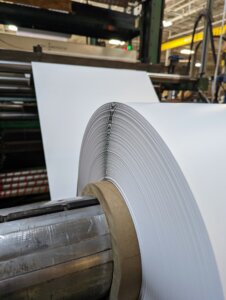Slot Die Coaters: The Basics Behind the Equipment

When should we use slot die coaters?
Slot die coating isn’t a process that fits every need perfectly—but with certain projects, nothing works better than slot die coaters. We’ll help you figure out if this equipment is something you need to consider.
On its most basic level, the slot die coating process is something we use to apply many different liquid chemistries, from a thin solution to a thicker slurry, onto a substrate. Usually, the substrates we work with when applying slot die coaters come in the form of glass, metals, or polymers. Keep in mind that a key feature of slot die coaters is their ability to dispense liquids at a controlled rate. As the machine deposits the liquid coating, the coating die moves relative to the substrate.
With all that in mind, we use slot die coaters when we need to work with thin films and coatings. The machines allow for a prioritization of thinness, achieving levels that aren’t found in comparable manufacturing processes. Additionally, certain industries have come to rely on slot die coating—it’s a “go to” process for them, and they keep permanent slot die coating machines at the ready (or work with consistent contract manufacturers).
How did slot die coating come to be?
Originally, the industry that relied most on slot die coating was actually photography. The thin layers achieved by slot die coaters were perfect for producing photographic paper and film. As such, it may not come as a surprise that the original patent for slot die coating was in fact filed by Eastman Kodak Co, all the way back in 1951.
However, over time, other industries discovered slot die coating and its uses. What makes slot die coating prized as a process is its relatively high output and efficiency levels. It’s reliable, easily scalable, and wastes little product. Many industries prioritize scalability above other aspects—and with good reason. Scalability ensures that you can increase the amount of product over a relatively short period of time, without sacrificing the quality of the product. The more clearly scalable slot die coating became, the more commercial industries came to prize it. Particularly, those that use nanomaterials.
What are the most notable qualities of slot die coating?
Let’s examine slot die coaters, how they work and their results a bit more closely.
Slot die coating machines are in part defined by their slot die heads. When examining a slot die head, you’ll notice several key components. These include a front plate, back plate, shim, and meniscus guide. The plates themselves serve as blocks that receive ink from the main delivery system, and otherwise keep the slot die head together. The shim and the meniscus, on the other hand, direct the ink towards the coating edge. They serve as the guiding components. The precision of these components really sets slot die coaters apart, ensuring a degree of consistency that is difficult to find elsewhere.
We can’t downplay the thickness control of slot die coating equipment either. As previously mentioned, the shim is part of what guides a slot die coating machine, ensuring the general desired pattern. A meniscus guide may accompany the meniscus, which stabilizes the fluid meniscus as it moves between the moving substrate and the slot die head. These factors ensure a greater control over the coating thickness.
Comparing Control Options
Another thing to consider is the “pre-metered” nature of slot die coaters. We can control the coated wet film thickness by calculating the machine’s pump rate, as well as the substrate motion speed, the rate at which the substrate accepts the applied solution, and the coating width. All of these factors even work into a formula, making this thickness control even simpler, and is a part of “pre-metering”.
In comparison, a “self-metered” coating technique offers far less control. With self-metered techniques the die head itself ultimately controls the thickness of the layer, based in large part on its height above the substrate. This leaves a lot of room for error, based on factors like the thickness of the solution, and the amount of the solution used, and requires a lot more interference and, at times, correction.
Do I need to handle my own converting?
Ultimately, it’s easy to see why slot die coating has become so necessary in a variety of industries. However, that doesn’t mean you know exactly how to begin the process yourself. In many cases, rather than investing in their own machines or employee training, business owners choose to outsource their slot die coating needs. In fact, seeking out third party slot die coating is fairly common.
The great thing about working with a third party manufacturer is that you not only get consistent results—it’s also easy to cut costs. You’re scaling up production, working with a reliable provider, and often saving money.
CTI can help you determine whether or not third party manufacturing is right for you—and if slot die coaters will serve your needs effectively. Give us a call at 419-924-5566, or reach out here for more information. We’re happy to assist!
- << < Previous Post
- 1
- 2
- ...
- 36
- ...
- 250
- 251 Next Post > >>

